Antipodes K50 Music Server
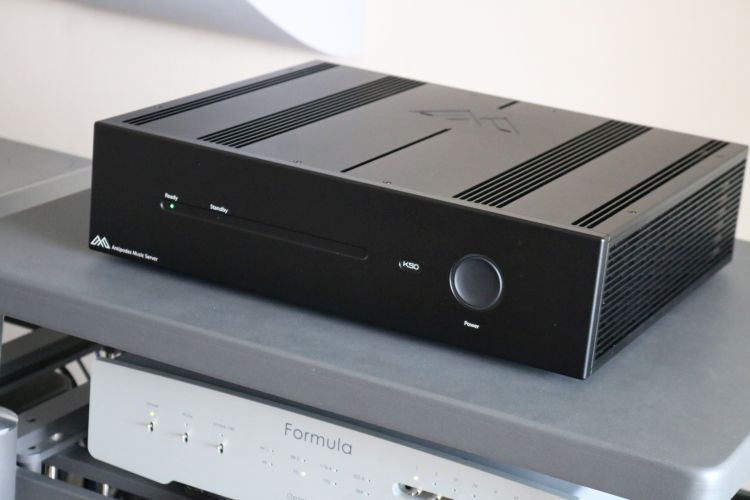
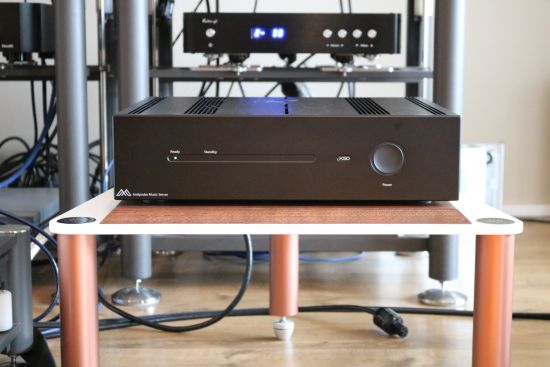
First Listening
My first impressions of the K50 were formed during the reviewing of the Aequo Stilla loudspeakers. As a result, I was using the Aqua Formula xHD DAC with the Audio-GD preamp and neither the Logans nor the Magicos were set up for use. But the relatively unfamiliar setup did not stop me from noticing right away how much of a Milestone product the K50 is.
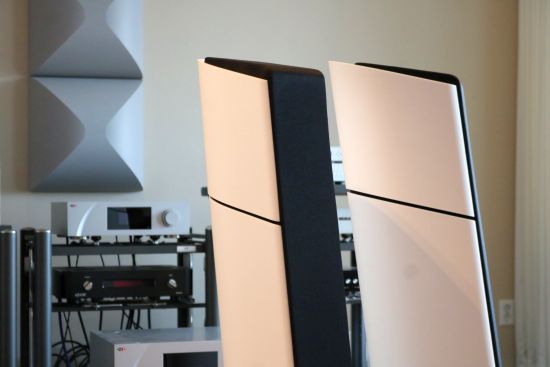
All of the K50’s three main sections are built with the highest quality in mind, and thus, the K50 works equally well as a Server only or a Player only. However, I soon found that the full extent of the K50’s magic happens when it is used as an integrated system.
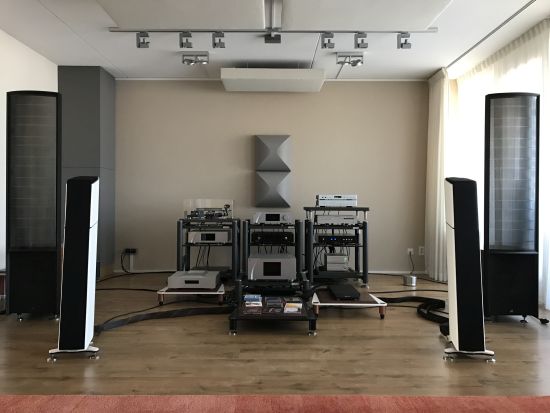
K50 as a player
When using the K50 as a Roon player, fed from CX in the capacity of a Roon Server, the K50’s very interesting Reclocking Digital Output section becomes available. For the comparison with the EX as a Player, though, I necessarily stuck to USB using the Final Touch Audio Callisto cable. Even so, the differences with the EX as a player were immediately obvious. The K50 has a sweeter and more refined treble, sounds rounder and more relaxed, and has more spacious, deeper soundstaging. Most noteworthy, though, the K50 sounds much more organic.
Although this combination possesses a refreshing lack of stridency that is otherwise so common in digital replay, I did feel that the sound could do with a little bit more tightness and sparkle. Adding the Bryston BDP-3 as a Player also connected to the DAC via USB, and fed by the CX, substantiated this feeling by providing faster pacing and more immediate transient behavior albeit at the cost of sounding more mechanical, less colorful, and flatter in terms of soundstaging.
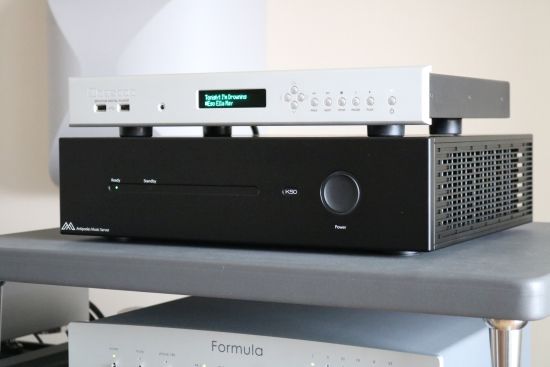
Somehow, I think the CX was undermining the K50’s performance. Somewhat puzzled by this mixed result, I decided that the next step would be to use the K50 integrally as a Server + Player and with its AES/EBU output.
K50 as a Server + Player
Switching to the complete K50 package as a Roon Server and Roon Player with its Reclocking Digital Output section and using the Jorma AES/EBU cable, still with the Aqua/Audio-GD/Aequo setup, the leap in performance was absolutely stunning.
This was definitely something else!
All of the aforementioned organic naturalness remains but with increased transparency, presence, speed, and impact. While the BDP-3 remains the King of tightness, all other aspects of the K50’s performance are just so much more involving. Most remarkably, the soundstage has a depth of imaging that reminds me of what the Wadia 861 CD player could do. At that time, I compared the player’s output and input independently and established that the player’s Clocklink function was crucial to it producing a deep soundstage. Since then, I have used countless servers and streamers with various connection methods but not a single unit has come close to reproducing that kind of depth without introducing unwanted side effects. Until now, that is.
One of the K50’s unique strengths is that it not only produces music in a natural and free-flowing manner, it also has great PRaT and the uncanny ability to reproduce everything in a most realistic manner, making all the instruments sound utterly authentic and convincing.
At this point, I was already smitten. Then, it hit me that it was only just Roon that I had been listening to. And not only that, so far, I had only heard one output and there were many more to assess!
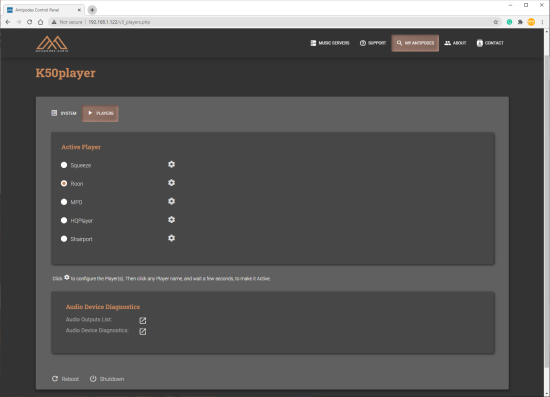
Other player Apps
Regular readers will know that I recently noticed that Roon did not sound quite as crispy and articulate as UPnP. As a result, I re-assessed all of my playback options and found that there are subtle differences from method to method (MPD, UPnP, Squeezelite) but Roon was the one standing out negatively for appearing somewhat thickened and crushed dynamically. This is really rather unfortunate because the Roon interface is so great. Fortunately, if you don’t want to switch to UPnP or MPD, there is a very easy solution. Ever since its inception, Roon has been working hard to be compatible with just about every hardware device and streaming format out there and that includes Squeezelite. As can be read in the K50 instructions, many users opt to combine the Roon server with the Squeezelite Player to achieve the best of both worlds.

To use Squeezelite with Roon, don’t forget to enable Squeezebox support in the Roon – Setup settings and to disable the Squeeze Server in the Antipodes interface.
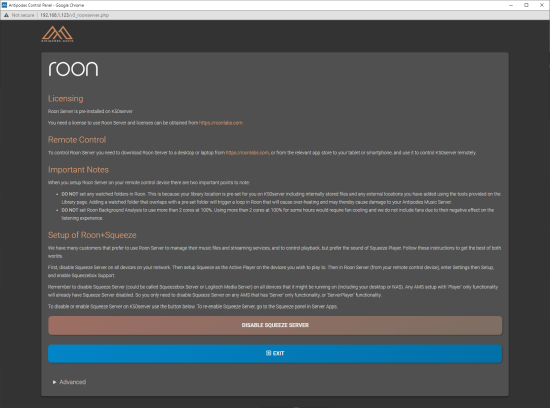
At this point, the Aequo speakers had been relegated to the other room and the Logans were back in their old positions and used for the remainder of this review.
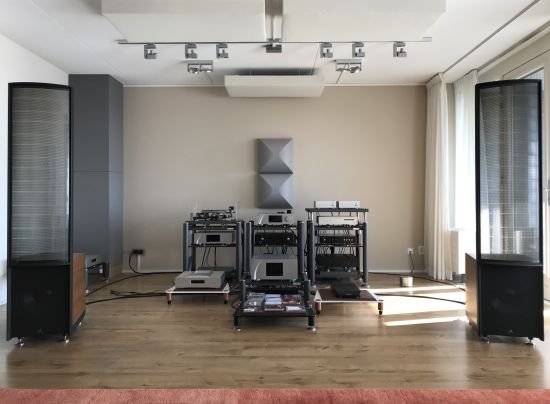
When comparing Roon Server + Roon Player to Roon Server + Squeezelite, the aforementioned Roon effect is not fully gone but the bass tightens up, transients become faster and the entire presentation just becomes a little bit directer and clearer – importantly, while retaining 100% of the organic naturalness.
If you want the absolute maximum in tightness, articulation, transparency and purity then MPD is the way to go. But that does mean that Roon cannot be used.
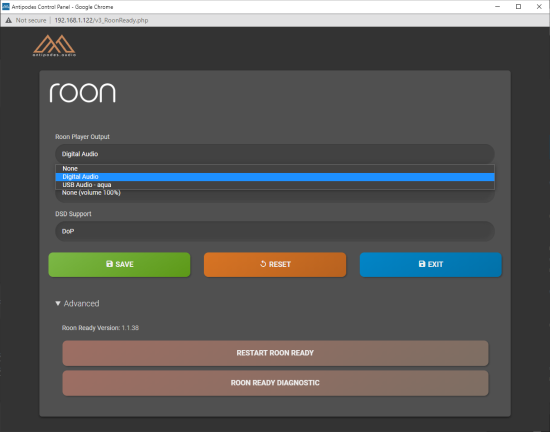
Note that the player zone name in Roon remains “Antipodes D2”, whether you select Digital Audio or Roon.
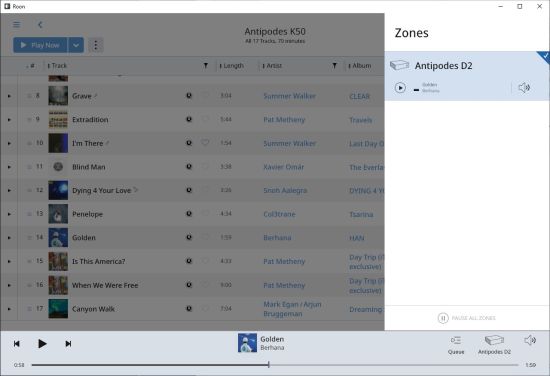
I do need to mention that the remaining difference between Roon+Squeeze and UPnP or MPD, while important to me, seems not to affect many other users quite as much. When asked about it, most admit to not having made comparisons but also not to be missing anything. Whenever I did do the comparison with someone else either at my place or theirs, however, the difference was there for both of us to hear. It’s not day and night, perhaps, but certainly “sunny day” versus “cloudy day”. Either way, I also recall that only two paragraphs back I already admitted to being smitten with the K50’s performance and that was with Roon Server and Roon Player. So, as always, it’s relative, just like pretty much everything else in the wonderful world of high-end audio.
See also the Connections section on the Antipodes website for an in-depth explanation of the server and renderer connections and configurations.







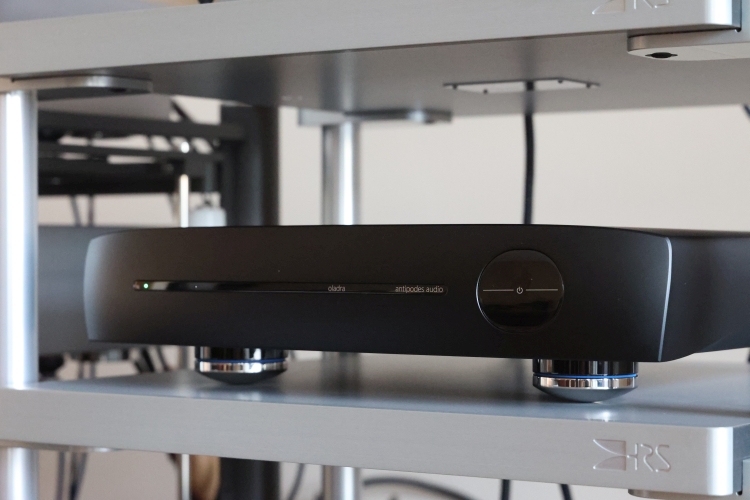
Christiaan — Thanks for the great review. I own the CX/EX combo, and am awaiting delivery of the K50 in a couple of days — very eagerly, as you might expect. I have always been impressed with Mark Jenkins’ design and engineering philosophy — he doesn’t buy into dogma, but trusts his own technical and listening skills. As a side note, I switched to using the tweaked version of LMS and squeezelite that they introduced last year — have u tried that? Sounds way better than Roon. I hadn’t thought of using Roon as the Server with Squeezelite, but it may be worth a shot. Thanks. — David
Hi David, I’ve not worked with LMS for a long time. Back when Logitech was still involved I did not like the sound too much, well not at all, actually. Where do you run the tweaked LMS version now with respect to the CX/EX? PS: if going outside of Roon then I personally prefer jRiver Media Center with UPnP for the extra-rich meta data / feature set, and this also sounds great.
Great review, thank you!
As a side note, can you list all the reviews in order, date etc will make it much easier to find reviews.
Thanks! Currently, reviews can be found by product type (amplifier/CD player, etc) from the main menu and these search results are alphabetical. You can also search by brand, see the brands cloud at the bottom of the home page or the brands list in the sidebar of each other page. The home page by default shows all articles by date. What other order specifically would you like to see?
Chris, last November, Antipodes announced new software upgrades, of which their tweaked LMS was a part. Here’s the relevant description in the email to customers:
“LMS Player.
LMS (also known as Logitech Media Server or Squeezebox Server) has always been the free option for music playback on Antipodes Music Servers. LMS has been significantly upgraded so that it is a very attractive alternative to other playback software options, and is free.
LMS has a huge range of features including streaming services, including QOBUZ, TIDAL, Radio Paradise, and a huge range of internet radio stations.
Antipodes has worked on optimising the sound quality of LMS on Antipodes Music Servers and it is now very competitive from a sound quality viewpoint.
Antipodes includes a resampling tool with LMS. One particularly useful feature is that it can play FLAC files by sending the WAV file equivalent to the renderer app, which improves naturalness compared to rendering the FLAC file. But you can also upsample and/or transcode to DSD.
One of the advantages of LMS is that the player is browser based. This means that you do not need a remote control application. The application is on the Antipodes Music Server and all you need to do is browse to it. The result is very fast response, using an application that won’t chew through your phone’s battery.”
As I mentioned in my earlier post, I ordered the K50 — it is humming away now. I noticed that the LMS has been rebranded as “Squeezeserver” (both work with the squeezplayer or squeezelite, I forget).
Worth checking out, IMHO. — David
Hi David, ah yes, of course. Well, I must confess to not having paid any attention to the Squeezeserver part. I just dismissed it without a second thought based on bad experiences long ago. Interesting what you mention about playing FLACs as WAVS. Time permitting, I may still investigate all this. Knowing that UPnP and MPD outperform Roon Server with Squeezelite, I wonder which would come out on top.
Christiaan, just one clarification. The comparison of WAV vs. FLAC belongs to Mark Jenkins — most of that post was an extended quote from his e-mail. I have no experience that isolates the 2 for comparison. Just the belief that LMS/Squeezeserver sounds markedly better than Roon. (One difference I can point out is cautionary — WAV does not display art dependably. When I was using Roon a couple of years ago, all my files were WAV, and only about half of my album covers were shown correctly. Ultimately, I used dbpoweramp to convert them all to FLAC and the problem was solved.)
On another note, I can confirm that the K50 is immediately and decisively better than the CX/EX combo, and quite stunning, after a few days of listening. I am eager to hear how much better it gets as the run in progresses. — David
Hi David, thanks for clarifying and I’m glad to hear that you are happy with your K50! Actually, it is perfectly possible to embed cover art in WAV files. I have been doing this for what feels like a decade using dB Poweramp, and besides embedding the metadata just to support those apps that do not read the embedded data properly, I also have set dB Poweramp to always place a cover art file in the root of the album folder called “Folder.jpg”. This covers it 100% in all the playback solutions that I have tried. I suspect that if it works unreliably for you then it is probably a matter of changing some settings.
Thanks, Christiaan. All my files are flac now, so the issue is moot. I’ll pass along one interesting tidbit/trivia Mark mentioned about flac, when I first got the CX/EX. I’m not sure I am describing it correctly, but the gist of it is that flac has some kind of parity checking built in — something that works against inevitable errors that creep in over time in magnetic storage media, that wav does not have. I haven’t verified (nor claim to really understand its working), and if someone other than Mark Jenkins mentioned it, I wouldn’t bother noting it. Archival storage is rarely discussed, but with more and more music libraries entrusted to magnetic media, it is an interesting question. How does one cope with the second law of thermodynamics? — David
Yes, an interesting question, indeed. However, I’m not sure if it really poses an issue due to the extra layers of correction built into the HDD/SSD storage systems as well as right in the PCM code itself.
Hi David, the K50 has sadly returned to the distributor (and I still have not recovered from that…) but I have tested LMS with Squeezelite versus Roon using the Antipodes CX via USB into the Aqua Formula xHD DAC and I agree that it sounds much better than RoonServer + RoonReady or Core Direct (bypassing RoonReady and going directly from server to USB). In fact, UPnP, MPD and Squeeze all sound better than Roon. There is some improvement when using Roon Server with Squeezelite as a player instead of RoonReady but the server part arguably puts the biggest mark on the SQ. Having done the comparison on the same machine with no cables changed, only switching between Roon and Squeeze via the web interface, we should safely be able to say that there are no external influences that could offset the results. iPeng is one of the best apps to control Squeeze but its interface is not equal to Roon. I will miss a lot of its functionality but the SQ is what matters most.
Hello Chris!
Great review, I am very happy to read it 🙂
Within a next 2-3 weeks I am going to get my example of K50 to test.
Nice!
Great review Christiaan. You really ought to get hold of a Taiko Audio Extreme and give it a listen. This K50 sounds like a game changer and would be really good to see how they tee up against one another.
Yeah, I agree. It has been on the list for some time but somehow it has not yet materialized.
Christiaan — I took a cue from your review, and tried the AES/EBU digital output on the K50. I have a different DAC and interconnect than yours, but had the same result. While the usb connection is excellent, there is a heightened sense of refinement, realistic depth of soundstage and greater resolution with the balanced hookup. Thanks for the tip. — David
Hi, i have already got k50!
So, the first impression is really good, K50 is next step, very interesting machine compare to EX-CX combo. My device is very new, also i have new SR Orange fuses, so it’s time to burning )
Nice, enjoy!
Hi – love your blog, bravo!!
I can’t afford the KS50, and am hesitating between a DX (gen 2) and an EX (without the CX).
FYI I have tried an Innuos Zenith mk3 and was favorably impressed with the sound but in Roon player mode (with my music library on a NAS). In Roon Core (music on the Innuos internal SSD), I was surprised to hear it sounded perhaps cleaner and tighter but also leaner and less sonorous/emotional to my ears.
What do you think?
Thank you!
Steph
I did review the DX (D2 v2.3) but have not compared it directly with the EX. My gut feeling would be that the DX might be better than the EX as an all-in-one solution. If you’re only using it as a RoonReady player then perhaps the EX might be better. But I’m really only guesstimating here.
There is indeed a difference between RoonReady and Core Direct sound but it depends on whether the device is also running the core or if it is a player. To my ears, a core/sever sounds tightests with Core Direct while a RoonReady player sounds tightest using RoonReady. Depending on the rest of the setup and your personal preferences, the tightness may also induce a sense of the music being leaner or less emotional.
Many thanks Christiaan for taking the time to answer, much appreciated! I am new to the world of servers/streamers (coming from initially a laptop with JRiver, that I replaced with a Raspberry Pi running Roon) and the learning curve is steep, but exciting!
Great review – the K40 is on my list of possible server upgrades as is the Pink Faun 2.16x which you have also reviewed very highly. In that review from 2019, you said ” On an audiophile level, it is easily the best server that I’ve heard so far.” Now you’ve said this of the K50 “The K50 is an Absolute Game Changer.” so a couple of questions –
– in what way does it better the Pink Faun 2.16x
– and which might be a better choice if all you need is an ethernet out to a streamer which, in my case, is a Linn KDSM
Thanks!
The differentiator here is “on an audiophile level”. Back when I reviewed the Pink Faun, it was clear that it produces a technically more accurate result than the CX+EX combo. But musically/emotionally speaking, I preferred the Antipodes combo. Today with the K50 the same perspective holds true but with on the one hand a bigger difference with the K50’s more organic and free-flowing sound and on the other hand a smaller gap with more refinement and resolution than with the CX/EX.
All that said, a music server has the most influence on the sound (and the best chance of optimum synergy) when you use both its server and player parts. This is true for the Pink Faun 2.16x (its specialized output modules) as well as for the Antipodes K50 (divided tasks between CX and EX or separated within the K50’s chassis). If you plan on using the Linn as an endpoint and use the server part then you are under-using the potential of the Pink Faun.
The K40, of course, is designed specifically as a server only. Thus, you would not be paying for hardware that you won’t use. While I have no experience using either of these two brands with a Linn DS and thus don’t know precisely how it will respond and you would use the OpenHome protocol, not Roon Raat as I did, still, I would wager that the Pink Faun might yield a snappier and more precise result while the Antipodes (K40 in this case) might yield a timbrally fuller, slightly more relaxed sound.
Thanks for your insights. I just ordered the K40 today so I’ll check in after it breaks in a bit.
Congrats! The main difference you’ll hear with running in is that the sound becomes smoother and more organic. The biggest change is heard in the first couple of days with further slower evolution after that which more or less plateaus after about a month. Reportedly, more bedding in happens after that but I’ve not witnessed this as my unit went back before that time.
I had the Aqua linq but due to certain cirqumstances it was replaced by a Antipodes S40. I am frankly quite surprised how good this sounds even with its most basic SMPS powersupply. So I guess the full blown K50 must sound really good.
Hi ,
Thank’s for this very interesting review of the K50 .
Myself I am in the diy world of servers/players as it is such a quick evolving world .
I am now in my third generation of such products and it is a serious effort as this last diy project is 6k euros for parts only .
All this long introduction to say that I fully agree with several things you have written.
My player now is the excellent ered dock card from engineered, I am using aes/ebu output and it is for me also the best digital link to a dac .
All my previous expensive efforts with usb showed it is somewhat compromised in sound quality .
I had the opportunity to try the Norma aes/ebu cable on my system and it is really excellent . In fact I compared it to my Kubala Sosna elation and it was in the same league with even a better bottom medium than the kubala .
Fully agree also with your comments about Roon that I did use before .
Will probably have a serious look on the k40.
Cheers
Great review, Christiaan!
I have a CH Precision i1 that is being used as a streamer, DAC and preamp going into a M1.1. Some day the i1 will be replaced with a C1 and L1.
i1 gets its Ethernet from a Roon Nucleus via an Etheregen switch and Sonore Optical Module combo.
Does replacing the Nucleus with a K40/50 make sense?
Thanks and keep up the great work!
Hi NB, alas, the music server retains an influence on the sound, no matter the infrastructure, the transport protocol, the connection method and the endpoint/streamer/renderer. Some argue that we’re talking nuances and the difference is not large enough to worry about but I have compared two Antipodes servers side by side in combination with the Aqua LinQ as a neutral streaming endpoint, and even then, there was an absolutely substantial difference between the two servers, no matter if I used Roon or MPD. In this direct comparison, the CX sounds bold and impactful but relatively squarish and low-res, while the K50 sounds much smoother and fluid, and more highly resolving.
I’m afraid I don’t know how the Nucleus compares. All I know is that it was designed to be stable, not necessarily with the best sound quality in mind.
Although I favor using AES/EBU to the C1 (which necessitates getting the K50), if you will get the network input option for the C1 and will only use the server as a pure server (not renderer) then the K40 will likely do just as well as the K50.
Hi Christiaan,
Really enjoying your reviews, thank you!
Comparing the K50 (and CX/EX) and Pink Faun above, you used terms like PF being “..technically more accurate..” and preferred Antipodes “musically/emotionally speaking”, and “K50’s more organic and free-flowing sound and on the other hand a smaller gap with more refinement and resolution” and “ timbrally fuller, slightly more relaxed sound”.
Could you please elaborate on those words, would it translate into EITHER more analogue than digital, not clinical, not harsh or bright or lean; OR smoother as in less resolving and transparent, less detailed or accurate?
When talking about CX/EX versus Pink Faun then the latter is more transparent and has more resolution. Everything you noted applies: “more analog than digital, not clinical, not harsh or bright or lean BUT ALSO smoother as in less resolving and transparent, less detailed or accurate”. Also note that I wrote that the PF was technically better because it was also quite static and controlled, not letting the music really breathe, which the Antipodes combo did do.
Recently, I was in the position to compare the K50 directly to the latest version of the Pink Faun server and while the main differences as heard with the CX+EX still hold true, the K50’s resolution has increased significantly. While the Pink Faun is still more articulate and tighter on the transients, the overall level of detail is no longer a major differentiator. Rather, it comes down to a matter of taste: a smooth and organic, slightly round and slightly warm presentation versus a drier, tighter, more accurate and more clinical presentation.
Thank you Christiaan for the further elaboration. I now think I have a better idea of their comparative characters.
Very helpful, thank you!
Hi Christiaan,
Ik ben een paar jaar geleden overgestapt naar de jou welbekende Aurender N10. Beviel mij zo goed dat ik mijn cd’s en lp’s nauwelijks nog gebruik, maar meestal via Qobuz stream.
Ik overweeg nu te upgraden, waarbij ik aan de K50 denk. Ik lees altijd je reviews en jouw smaak qua weergave komt overeen met de mijne. Het blijft echter een forse investering en ik wil dit alleen doen als het een duidelijk merkbare verbetering is en niet de laatste puntjes op de i.
Ik heb het gevoel dat dit zo is, maar hoe kijk jij hier tegenaan? Rest van de keten zijn losse Gryphon componenten met SF Amati Homage speakers.
Aurender and Antipodes have very different presentations and different strong areas. Please read my review of the Aurender N10 and my subsequent Antipodes reviews (for instance the DX or the EX/CX) for all the details and comparisons with Aurender.
Hi Christian,
I have obviously read your reviews. I got the clear impression from your first review of an Antipodes, the DX2, that you favor this Antipodes above the Aurender and that you liked each subsequent model even better, with now the K50 as the pinnacle.
Hence my question, is the K50 in your view really a significant step forward, a game changer as you call it, or are we in the end talking about evident bit still marginal improvements?
Yes, the K50 is a significant step up from the EX and CX. Not marginal but substantial. As I have described, it is hard to return to the CX/EX after living with the K50 for a while.
Hi Christaan,
Drove yesterday to Groningen to compare the Aurender to the K50. From your reviews, I got the impression that Antipodes’ give a “full sound” with wood and strings, but for certain not only strings. The K50 did this, but in a total different manner I had expected. In my own words, I am not a reviewer:
The Aurender gave – first impression – a fuller sound but when I listened better it was like a wall of sound which came towards me. The K50 appeared very relaxed, it seemed as if I could see through the music, it was no longer “a wall of sound” and I could hear details far better (eg a piano from the moment the pianist hit the key until the decay died away). Far less tiresome. Voices (and instruments) were no longer part of the music, but everything stood clearly on its own. All in all, more resolution, detail and far less fatique to listen to it.
So in the end, I decided to plunge in and forget about the crazy investment….
Hi Jeff, congrats on your new purchase! Please keep in mind that it needs 2-3 months before it sounds as relaxed as a fully run-in sample. I think what you describe as the K50 presentation is what I refer to as unforced and organic. The Aurender N10, by comparison, I feel is dimensionally flatter (the wall you mention) and dynamically as well as lyrically restrained.
Does anybody btw know the thread size of the K50 feet?
I would like to use my Stillpoints ultra ss feet again, but cannot find any details via google or Stillpoints.
This is not known, might I suggest checking with the manufacturer? That said, I’m afraid that a very small thread is used, smaller than Stillpoints would have available. Why not use them free-standing (tip pointing up) underneath the K50? I found that this worked well with a variety of equipment.
Hi Christiaan,
I am for 9 months mote than happy with the K50. The new update was somewhat troublesome but thanks to the Dutch importer sorted out properly. I missed the unit long enough to be uncertain whether I hear an improvement, but that is not my question.
I read nearly everywhere that people prefer Squeeze above Roon and Squeezelite above the Roon player. I have never come across a review which states the opposite. So I tried it a couple of times (Roon with squeeze player) but I personally don’t like it. I hear voices and instruments more defined, but they have simultaneously a lighter footprint. People think Roon is blurred, but I feel that Squeeze is more lifeless and clinical and that Roon adds atmosphere and weight to the presentation. I also believe Roo’s presentation is wider.
I know that you cannot argue about personal preferences, but I am a total nobody in professional audio terms and I am curious what you think that I am hearing.Funny question, I realize. Does Roon pronounce the mid tones more? Looks more than that. Just curious. And what are your personal observations?
Hi Jeff, this is a great example that shows how these things are relative. That’s why I always try to put as many descriptors in my reviews as I can think of, simply because “better” for one person may not be better for another. From your descriptions, I think you are hearing the same differences as I am, but in your system or for your taste, it just works out better the other way around. That’s perfectly valid!
For me, Roon adds some warmth and richness that makes for a thicker/fatter bass, smoother mids, and an overall more relaxed sound than MPD, UPnP, or Squeeze typically produce. For me, tighter and cleaner is better, but that’s certainly not a rule! The reverse would lead to someone like yourself finding UPnP, MPD, or Squeeze overly lean and controlled-sounding.
I would say don’t worry about it. But do keep it in mind for when your system changes, when, at some point, the balance may tip.
Very late to this, but after comparing Roon+Roon and Roon+Squeeze I preferred the latter. However, the big difference with my virtually new K22 and v5 software is switching from USB into my Bricasti DAC to AES, and the latter gives both a clearer and ‘fatter’ sound despite the improvements to the Antipodes USB. I didn’t really want this to be so because of the DSD rate advantages of the USB, but it’s undeniable.
AES sounding “Fatter”, I can understand, as USB is indeed still relatively tighter and cleaner, even with the latest server platforms. However, AES sounding “clearer” is not conform to my testing. My first thought would be to look at the cables used as they can have a very large influence.
Have you experimented with hqplayer oversampling through roon vs the grim mu1s internal oversampling?
I did indeed and found that software resampling sounds different than hardware resampling. Back in the day with the dCS Delius and Purcell, I experienced a profound difference as well when compared to upsampling in a piece of software that I can’t recall now. In any event, in the case of the Grimm, the resampling changes the character of the sound (see my MU1 review), whereas resampling in Roon (whether on the K50 or another server) does pretty much only what it should do and can only add a moderate and expected rounding under certain circumstances. While I would generally regard software resampling to be more transparent, it is with hardware solutions that more profound differences can be achieved, and in many cases, a more desirable result (I’m not saying necessarily more accurate, although the manufacturer might disagree). But in the case of the Grimm, I’d say the results are extremely likable and for the most part only beneficial. The stage becomes considerably deeper and more spacious and the tonality becomes fuller. Where it is not beneficial, in my opinion, is in the bass, which becomes rounder and less incisive. Then again, software resampling has a similar effect in the bass, and usually not as much effect on the soundstage.